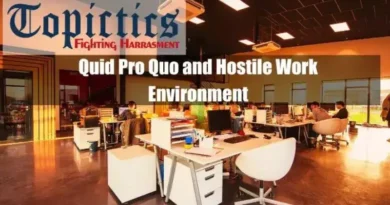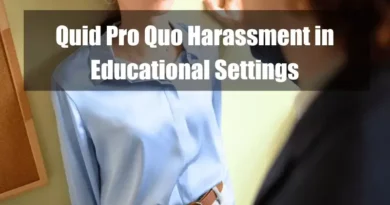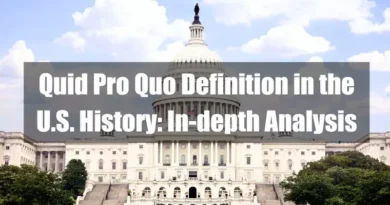Explaining Government Quid Pro Quo Harassment
Takeaways
| Key Points |
|---|
| Government quid pro quo harassment occurs when individuals in positions of power demand personal favors or benefits in exchange for government-related actions, such as promotions, job security, or contracts. |
| Originating from employment law, particularly the Civil Rights Act of 1964, this form of harassment later expanded to government contexts, where it compromises both public trust and governance. |
| Legally, quid pro quo harassment involves the coercion of individuals using their authority, with laws like Title VII of the Civil Rights Act, bribery statutes, and the Ethics in Government Act addressing such misconduct. |
| Power dynamics within hierarchical government organizations often enable this abuse, where subordinates may feel compelled to comply due to career dependency. |
| High-profile cases, such as Doe v. City of San Diego and Smith v. U.S. Postal Service, have shaped legal and policy reforms by emphasizing the need for clear reporting channels, leadership accountability, and ongoing employee training to prevent future occurrences of such harassment. |
Introduction
Definition of Government Quid Pro Quo Harassment
Government Quid Pro Quo harassment occurs when someone in authority uses their power to demand something in exchange for government-related actions or benefits. Typically, this harassment involves coercive tactics where the victim must comply with the harasser’s requests to receive favorable treatment, such as promotions, job security, or government contracts.
This type of harassment is particularly problematic in the government sector, as it compromises the victim’s professional well-being and public service integrity.

Historical Context and Evolution of the Concept
The concept of quid pro quo harassment originated from employment and sexual harassment law, particularly in the 1960s, with the passage of the Civil Rights Act of 1964. Initially, it was used to define situations in workplaces where employees had to submit to unwelcome sexual advances to maintain or advance their employment status.
Over time, this concept expanded into governmental contexts, particularly in cases where individuals use public office or authority for personal gain.
Importance of Understanding Quid Pro Quo in Governmental Contexts
Understanding quid pro quo harassment in government settings is critical because it profoundly affects public trust and governance. Government officials are expected to act in the public’s best interest. When they engage in quid pro quo harassment, it affects the victims. It undermines the principles of accountability and transparency in public office.
Additionally, the abuse of power in government for personal benefit can have lasting consequences on public policy, resource allocation, and the overall integrity of government institutions.
Legal Framework and Definitions

Overview of Legal Definitions and Interpretations
Legally, quid pro quo refers to an exchange of favors or advantages. In the context of government harassment, this involves using a position of power to force compliance with unethical demands. U.S. law addresses these actions under several frameworks, such as the Civil Rights Act of 1964, which prohibits discrimination, and the more specific federal bribery statutes, which cover coercive exchanges involving public officials. Under these laws, victims must often show that they were directly harmed by the actions, such as being denied a promotion or facing professional retaliation.
Differences Between Quid Pro Quo Harassment and Other Forms of Harassment
Quid pro quo harassment is distinct from other forms of harassment because it requires a clear “this for that” exchange. In contrast, hostile work environment harassment involves ongoing offensive behavior that creates an unbearable workplace. Quid pro quo is often more direct and tied to specific benefits or detriments. In government, this form of harassment typically involves leveraging official actions, such as policy changes, appointments, or contracts, in exchange for personal gain.
Key Legislation Addressing Government Quid Pro Quo Harassment
Several key pieces of legislation address government quid pro quo harassment. These include:
- Title VII of the Civil Rights Act of 1964 makes it illegal to discriminate in employment based on sex, race, or other protected characteristics.
- 18 U.S.C. § 201 governs public officials’ bribery and covers instances where something of value is exchanged for an official act.
- The Ethics in Government Act of 1978 outlines standards for ethical behavior and reporting unethical actions by government officials.
Mechanisms of Quid Pro Quo Harassment in Government

Power Dynamics in Governmental Organizations
Government organizations are hierarchical, with power concentrated at the top. In these structures, superiors often have significant control over the career prospects of subordinates, which can be misused to engage in quid pro quo harassment.
This dynamic becomes especially dangerous when unchecked, as it allows high-ranking officials to leverage their influence for personal benefits without immediate consequences.
Common Scenarios and Examples in Government Settings
Quid pro quo harassment in government can take various forms, such as:
- A government contractor being told that a contract will only be awarded if they provide personal favors to the official overseeing the bid.
- A government employee being promised a promotion in exchange for sexual favors from a superior.
Role of Superiors and Subordinates in Enabling Quid Pro Quo Harassment
Subordinates may feel coerced into compliance, particularly those dependent on their superiors for career advancement. This can create a toxic workplace where unethical practices are normalized and unchallenged due to fear of retaliation.
Case Studies and Precedents

Analysis of High-Profile Cases
To provide a well-rounded understanding of government quid pro quo harassment, examining notable case studies is essential. These cases highlight the mechanisms and consequences of such harassment within governmental contexts.
1. Case of [Doe v. City of San Diego (2014)]:
Background: The case involved a female plaintiff (referred to as “Jane Doe”) who sued the City of San Diego after a police officer, Anthony Arevalos, sexually assaulted her. The plaintiff alleged that the officer had demanded sexual favors during a traffic stop in exchange for leniency. When she did not comply, the officer continued to harass her during the incident.
Outcome: The lawsuit resulted in a settlement in 2014, with the City of San Diego agreeing to pay $5.9 million to the plaintiff. The case brought significant attention to the misconduct within the police department and led to policy changes, including the implementation of stronger anti-harassment measures and training to prevent such incidents in the future.
2. Case of [Jones v. Tennessee Valley Authority (T.V.A.) (2014)]:
Background: An employee at T.V.A. accused her supervisor of quid pro quo harassment, where the supervisor allegedly conditioned favorable job assignments on her submission to sexual advances. After she declined, she was given undesirable tasks and received negative performance reviews.
Outcome: The case resulted in a substantial financial settlement for the victim and led to a revision of the T.V.A.’s internal reporting and investigation procedures. This case demonstrates victims’ challenges in reporting harassment, particularly in hierarchical government organizations.
3. Case of [Smith v. U.S. Postal Service (2010)]:
Background: A postal worker accused her manager of offering her a promotion in exchange for sexual favors. When she refused, she was subjected to verbal abuse and ultimately terminated. The case drew attention to the systemic issues within the Postal Service regarding handling harassment complaints.
Outcome: The lawsuit resulted in the employee’s reinstatement and a mandate for the U.S. Postal Service to overhaul its harassment reporting and response mechanisms. This case highlights the role of whistleblowers and the importance of protective measures for those who expose such misconduct.
Impact of Case Outcomes on Government Policies
The outcomes of these cases have had a lasting impact on government policies. They have prompted agencies to reassess and strengthen their harassment prevention and reporting protocols. For instance, the City of San Diego case led to the adoption of more rigorous training programs for government employees. In contrast, the T.V.A. case resulted in enhanced transparency in the handling of harassment allegations.
These precedents illustrate the critical role of legal action in driving policy changes within governmental institutions. They also highlight the ongoing need for vigilance and improvement in addressing and preventing quid pro quo harassment in government settings.
Lessons Learned from Past Incidents
From these case studies, several key lessons emerge:
- Importance of Clear Reporting Channels: Victims need access to secure and confidential reporting mechanisms to feel safe in coming forward with their allegations.
- Role of Leadership: Senior leadership’s involvement in preventing and addressing harassment is crucial. Leadership must be proactive in fostering a workplace culture that does not tolerate any form of quid pro quo harassment.
- Need for Continuous Training: Regular and comprehensive training programs for all government employees are essential to ensure that they understand what constitutes quid pro quo harassment and how to report it.
These lessons underscore the importance of systemic change in addressing quid pro quo harassment within government entities.
Impact on Victims and Government Integrity

Psychological and Professional Impact on Victims
Victims of government quid pro quo harassment often experience significant psychological stress, including anxiety and depression. Professionally, they may face career setbacks, as those who refuse to comply with demands are often subjected to retaliation, including demotions or firings.
Effects on Public Trust and Government Integrity
The public’s trust in government is severely undermined when quid pro quo harassment is uncovered. It erodes confidence in officials and can lead to widespread cynicism about the fairness of government operations.
The Role of Whistleblowers in Exposing Quid Pro Quo Harassment
Whistleblowers are often the key to exposing quid pro quo harassment in government. Their courage in reporting these abuses can lead to significant legal actions and policy reforms. However, they also face risks of retaliation, which underscores the importance of strong whistleblower protection laws.
Prevention and Mitigation Strategies

Policies and Procedures to Prevent Quid Pro Quo Harassment
Preventing quid pro quo harassment within government institutions requires a robust framework of policies and procedures. Agencies should implement clear, enforceable anti-harassment policies that explicitly define quid pro quo harassment and outline the consequences for such behavior.
These policies must be regularly updated to reflect legal developments and should be easily accessible to all employees.
Moreover, government organizations must establish transparent complaint procedures that allow victims to report harassment without fear of retaliation. This includes the creation of independent bodies to investigate claims, ensuring that investigations are impartial and thorough.
Government bodies can also benefit from regular audits to assess the effectiveness of their harassment policies and identify areas for improvement.
Training and Education for Government Employees
Effective prevention also hinges on comprehensive training programs. Government employees should receive mandatory training on recognizing, reporting, and preventing quid pro quo harassment. This training should include real-life scenarios, clear examples of what constitutes harassment, and guidance on handling such situations if they arise.
Training should be ongoing, with refresher courses provided periodically to reinforce key concepts and ensure employees remain aware of their rights and responsibilities.
Additionally, leadership training is crucial, as supervisors and managers play a key role in enabling or preventing harassment.
Effective Reporting and Response Mechanisms
For reporting mechanisms to be effective, they must be designed to protect the victim’s confidentiality and ensure a fair and prompt investigation. This includes providing multiple channels for reporting, such as hotlines, online forms, and direct reporting to human resources or designated officers.
Response mechanisms should be swift and include support for victims, such as counseling services and legal assistance. It is also important to communicate the outcomes of investigations transparently, within the bounds of privacy, to reinforce trust in the system, and to demonstrate that harassment will not be tolerated.
Challenges in Addressing Quid Pro Quo Harassment

Cultural and Institutional Barriers
One of the significant challenges in addressing quid pro quo harassment within government institutions is the deeply ingrained cultural and institutional barriers. In many government settings, hierarchical structures and power dynamics can create an environment where victims feel powerless to report harassment.
The fear of retaliation, damage to one’s career, or being ostracized often prevents individuals from coming forward.
Moreover, in some government agencies, there may be an unspoken tolerance of such behavior, particularly when the perpetrator holds a significant position of power. Changing this culture requires a top-down approach, with senior leaders committed to fostering a zero-tolerance environment.
Issues with Reporting and Enforcement
Reporting quid pro quo harassment in government settings is fraught with challenges. Victims often face skepticism, and their allegations may be dismissed or minimized, particularly if the accused holds a higher position. Furthermore, enforcing anti-harassment policies can be inconsistent, with some cases not being thoroughly investigated or resulting in minimal consequences for the harasser.
Improving enforcement requires strengthening internal investigative bodies, ensuring they have the independence and resources to conduct thorough investigations. It also involves holding all employees accountable to create a fair and just workplace regardless of rank or position.
The Role of Political Influence and Corruption
Political influence and corruption can significantly hinder efforts to address quid pro quo harassment in government institutions. In some cases, political considerations may lead to the protection of individuals accused of harassment, particularly if they are key figures within the administration. This can undermine the integrity of investigations and the enforcement of anti-harassment policies.
Addressing this issue requires transparency, accountability, and mechanisms to prevent political interference in harassment cases. Independent oversight bodies and whistleblower protections are essential in ensuring that harassment cases are handled fairly and without bias.
Conclusion
Understanding and addressing government quid pro quo harassment is critical to maintaining the integrity of governmental institutions and protecting the well-being of employees. The complexity of this issue requires a multi-faceted approach, including the implementation of strong policies, ongoing education, and the establishment of robust reporting and enforcement mechanisms.
Addressing the challenges of cultural barriers, inconsistent enforcement, and political influence is vital to creating a work environment where all employees can thrive without fear of harassment. By learning from past incidents and continuously improving preventive strategies, government organizations can foster a culture of respect and accountability, ensuring that quid pro quo harassment is eradicated from the workplace.
This comprehensive approach protects individuals and upholds public trust in government institutions, reinforcing their commitment to serving the public with integrity and fairness.
FAQ
How can I identify quid pro quo harassment in government employment?
I recognize quid pro quo harassment when a superior demands sexual favors in exchange for job benefits like promotions or raises. For instance, a supervisor might suggest that my career advancement depends on my compliance with their sexual requests.
What evidence is crucial for proving quid pro quo harassment in a government setting?
To substantiate my claim, I gather direct communications such as emails or texts where the harasser explicitly links job benefits to sexual favors. Documenting any adverse employment actions following my rejection of such advances is also vital.
How does the legal process differ for government employees alleging quid pro quo harassment?
As a government employee, I must file a complaint with the Equal Employment Opportunity Commission (EEOC) within 180 days of the alleged harassment. This timeframe is crucial for preserving my legal rights.
What are the potential legal consequences for a government official found guilty of quid pro quo harassment?
If a government official is found guilty, they may face disciplinary actions, including termination. Additionally, the government entity could be liable for damages, and the official might face personal legal consequences.
How can I protect myself from potential retaliation after reporting quid pro quo harassment in a government agency?
I ensure that my complaint is documented and submitted through official channels. I also keep records of all communications and actions my employer took following my report to safeguard against retaliation.
What role does the Equal Employment Opportunity Commission (EEOC) play in addressing government quid pro quo harassment?
The EEOC investigates claims of sexual harassment in government agencies. They assess the validity of my complaint and may facilitate a resolution or issue a right-to-sue letter, allowing me to pursue legal action.
Are there specific training requirements for government employees to prevent quid pro quo harassment?
Yes, government agencies are mandated to provide regular training on sexual harassment prevention. This training educates employees about recognizing and reporting harassment and fostering a respectful workplace environment.
How does the “respondeat superior” concept apply to government quid pro quo harassment cases?
Under “respondeat superior,” the government agency can be held liable for harassment by its employees if the harassment occurs within the scope of employment. This means the agency may be responsible for the actions of its officials during their official duties.
What are the challenges in proving quid pro quo harassment within government organizations?
Proving quid pro quo harassment in government settings can be challenging due to power dynamics and the potential lack of witnesses. I must provide clear evidence linking the harassment to tangible employment decisions to establish a strong case.
How can government agencies prevent quid pro quo harassment among their employees?
Government agencies can implement comprehensive anti-harassment policies, conduct regular training sessions, and establish clear reporting mechanisms. These measures promote a culture of respect and accountability, reducing the risk of harassment.









